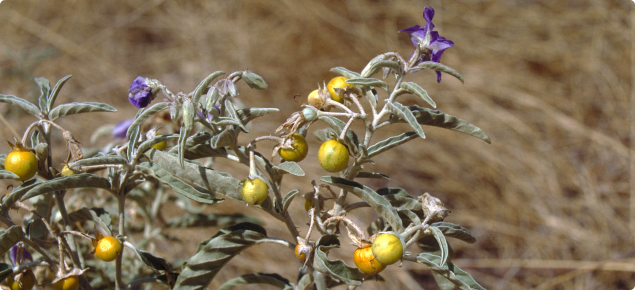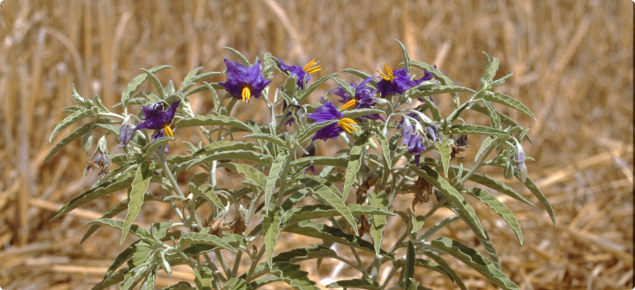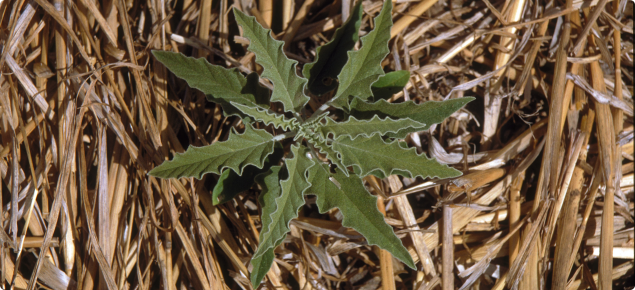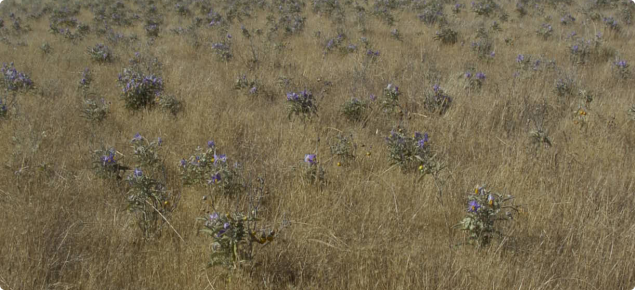Form: herbaceous — perennial
Status: present in WA
Silverleaf nightshade is native to southern South America and possibly also parts of North America. Thiss weeds has been prioritised at a national level as Weed of National Significance (WoNS).
Appearance
A summer-growing perennial herb up to 60 or 80 centimetres high. Deep roots penetrate up to two metres into soil. Roots remain viable and produce new plants from buds even when main plant appears to have died off.
Stems: much-branched, usually densely covered in whitish hairs (giving a silvery appearance) also usually with slender two to five millimetres long red/yellow spines.
Leaves: usually densely covered in whitish hairs (giving a silvery appearance). Oblong with wavy margins. Up to 10 centimetres long and one to three centimetres wide on a one centimetre stalk.
Flowers: star shaped with five petals, usually blue/violet, sometimes white. two to four centimetres diameter on a stalk up to one centimetre long.
Fruit: smooth, round, green berry with darker green markings when young ripening to yellow/brown. Up to 15 millimetres in diameter.
Seeds: flat, brown and up to four millimetres across. Many seeds per fruit.
Online weed identification training
Login or set up a new account on DPIRDs online training site to access:
- a training course on how to identify silverleaf nightshade and report it.
- training material that you can use to teach community groups how to identify silverleaf nightshade.
Agricultural and economic impact
Silverleaf nightshade invades crops, causing yield losses up to 75% in the eastern states. Silverleaf nightshade can also reduce the carrying capacity of pastures.
Declared pest category
The Western Australian Organism List (WAOL) contains information on the area(s) in which this pest is declared and the control and keeping categories to which it has been assigned in Western Australia (WA). Search for: silverleaf nightshade in the WAOL using the scientiifiic name Solanum elaeagnifolium.
Requirements for land owners/occupiers and other persons
Requirements for land owners/occupiers and other persons if this pest is found can be sourced through the declared pest plant requirements link.
Search > detect > report
| MyPestGuide™ Reporter | Pest and Disease Information Service (PaDIS) |
Detectability: hard to find: with its ‘silvery’ leaves and purple flowers, silverleaf nightshade is similar in appearance to several native Solanum species, including some that are present in the South West Land Division. Silverleaf nightshade can be distinguished from native species by its wavy leaf margins.
Who is likely to find it: farmers, biosecurity groups, local government, main roads, general public, particularly in the Great Southern.
When to find it: silverleaf nightshade is most likely to be found in summer and autumn.
Where to find it: silverleaf nightshade can be found in crop and pasture paddocks, paddock margins, around farm buildings and yards, along roadsides and railway lines and other disturbed areas.
Control method
Control methods for this declared plant can be found through the silverleaf nightshade - NSW WeedWise page
Further information
Additional information can be obtained in the Australian best practice manual - Silverleaf nightshade.
Management calendar




